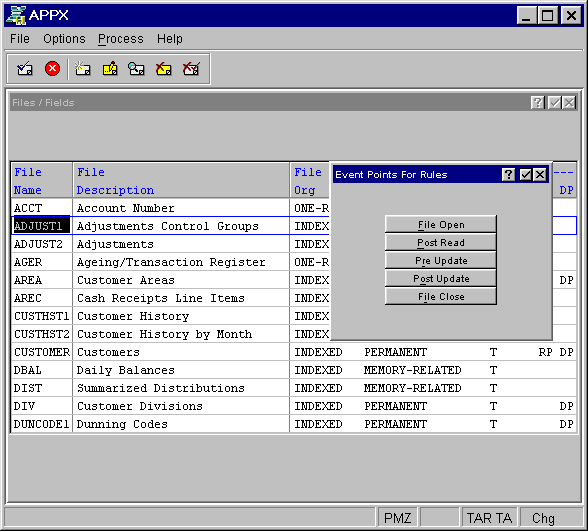


Files Rules Option
The Rules option from the Files/Fields screen accesses the File-Level Event Points for Rules overlay shown in Figure 2-4-3 below. This option allows you to define ILF code that is executed whenever the designated file is accessed or updated in any APPX process.

Figure 2-4-3. File-Level Event Points for Rules Overlay
File-level ILF code can be placed in the following event points:
· File Open to execute the code whenever the file is opened by a process
· Post Read to execute the code immediately following the execution of a read statement (READ, READNEXT, or BEG READ) or automatic read of the file when designated as a PCF file
· Pre-Update to execute the code immediately prior to the issuance of an update statement (WRITE, REWRITE or DELETE) or automatic update of the file designated as a PCF file
· Post Update to execute the code immediately following the issuance of an update statement (WRITE, REWRITE or DELETE) or automatic update of the file designated as a PCF File
· File Close to execute the code whenever the file is closed by a process.
Using file-level event points localizes complex update rules into a single location, assuring that your code executes for every update. Since these event points execute within the context of a file-level process, they share very little data with other processes. In fact, the only thing shared between a file-level process and the “foreground” process is the PCF record butter. For example, in the Post Read event point, you have access to the contents of the record just retrieved. If changes are made in the record buffer, those changes are reflected in the foreground process. In the Pre-Update event point, you have access to the PCF record buffer as delivered by the foreground process. File-level event points use their own copies of work variables so even work fields are not shared with other processes.
To create file level event points, simply select the option corresponding to the desired execution point. See the Event Points and File-Level Event Points sections for further information.
APPX Application
Design Manual (01/13/03)



© 2003 by APPX Software, Inc. All rights reserved